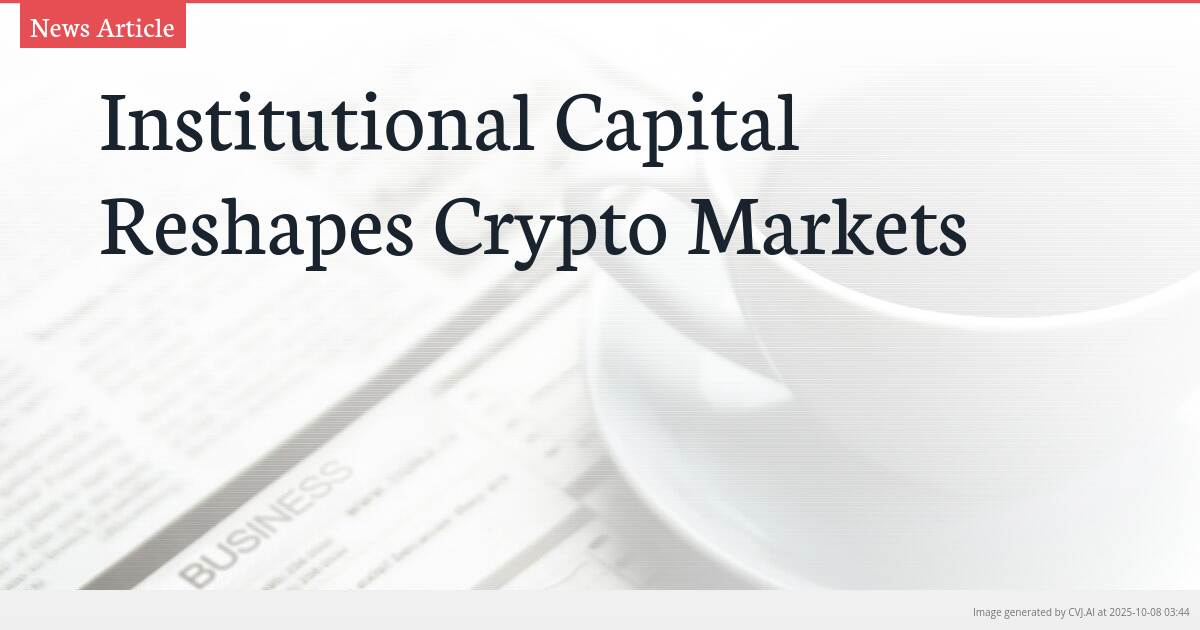This summary text is fully AI-generated and may therefore contain errors or be incomplete.
Introduction
Institutional investors are fundamentally transforming cryptocurrency markets, shifting from speculative trading to long-term strategic allocations. Executives from Bitwise Asset Management and Aspen Digital reveal how Bitcoin ETFs and improved infrastructure are driving this structural change. The market is witnessing steady institutional inflows replacing volatile retail speculation.
Key Points
- Bitcoin ETFs have attracted $50 billion in total inflows since launch, with steady quarterly investments continuing at $5-10 billion
- Institutional custody solutions from providers like Coinbase and Fidelity have largely resolved previous security concerns for large investors
- Family offices and wealth managers now treat crypto as a small but meaningful long-term portfolio allocation rather than speculative trading
The Bitcoin ETF Revolution: A New Era of Institutional Adoption
The launch of spot Bitcoin exchange-traded funds has marked a watershed moment for cryptocurrency markets, with institutional capital flooding in at an unprecedented pace. According to Hong Kim, Chief Technology Officer and co-founder of Bitwise Asset Management, the first year of Bitcoin ETFs saw approximately $30 billion of inflows, followed by an additional $20 billion this year alone. “Every quarter, we’ve had steady inflows of $5 to $10 billion. It’s not stopping,” Kim told Decrypt during the Token2049 conference in Singapore. He described the ETF launch as “the IPO moment for Bitcoin,” signaling a fundamental shift from retail-driven speculation to institutional-led accumulation.
The scale of institutional participation is now quantifiable and substantial. U.S. spot Bitcoin exchange-traded funds currently hold more than $169 billion worth of Bitcoin, equivalent to roughly 6.8% of the asset’s total market value according to data provider SoSoValue. This represents a structural transformation in how Bitcoin is being valued and traded, with public companies and professional investors now driving market flows rather than individual retail traders. Kim emphasized that this steady pace of inflows reflects a more durable form of demand than in previous market cycles, suggesting the current bull market has fundamentally different underpinnings.
Family Offices and Wealth Managers Embrace Strategic Crypto Allocation
The changing nature of crypto investment extends beyond ETFs to encompass how high-net-worth investors and family offices approach digital assets. Elliot Andrews, chief executive of Aspen Digital, noted that sophisticated investors are treating crypto as a long-term allocation rather than a speculative trade. “The days of chasing 100x returns are over,” Andrews told Decrypt. “Clients want consistent, risk-adjusted performance. For most, crypto sits as a small but meaningful part of a diversified portfolio.” This represents a maturation in investment philosophy, where cryptocurrency is being integrated into traditional portfolio construction frameworks rather than treated as a separate, high-risk speculation.
The shift toward strategic allocation reflects broader changes in how institutional investors perceive cryptocurrency’s role in wealth preservation and growth. Both Kim and Andrews noted that investors are increasingly viewing Bitcoin as a hedge against the debasement of the U.S. dollar, particularly amid political uncertainty in Washington. The recent 8% price surge following the U.S. government’s announcement of a partial shutdown, with Congress deadlocked over funding bills, underscores this emerging narrative. As traditional financial markets grapple with political instability, institutional investors are turning to Bitcoin as a non-sovereign store of value.
Infrastructure Maturation and Regulatory Clarity Enable Institutional Participation
The dramatic increase in institutional participation has been enabled by significant improvements in crypto infrastructure and regulatory clarity. According to Bitwise’s Hong Kim, custody for institutional products “has largely been solved,” citing established providers such as Coinbase, Anchorage, and Fidelity. He specifically pointed to the U.S. Securities and Exchange Commission’s recent clarification that state-chartered trusts qualify as custodians, removing a significant barrier for traditional financial institutions seeking crypto exposure.
Elliot Andrews of Aspen Digital highlighted how structural and political changes have alleviated concerns that previously prevented wealthy clients from investing in crypto. “The reason we exist is because private banks wouldn’t touch crypto when we started,” Andrews explained. “Their clients wanted exposure, but the banks needed a trusted venue to send them to.” The emergence of regulated intermediaries and institutional-grade service providers has created the necessary infrastructure for large-scale capital deployment into digital assets.
Analysts note that this infrastructure development has had a stabilizing effect on cryptocurrency markets. The growth of institutional vehicles has helped reduce volatility by replacing short-term speculative trading with steady inflows from wealth managers and investment advisers. This structural shift has contributed to Bitcoin’s recent price stability and its climb to new all-time highs, demonstrating how institutional participation is fundamentally altering market dynamics. As Kim summarized, “The volatility will come in bursts, but the underlying story is one of steady accumulation.”
📎 Read the original article on decrypt.co

